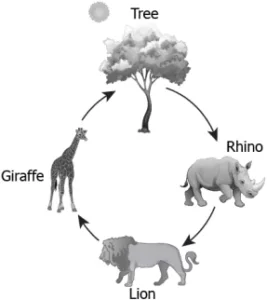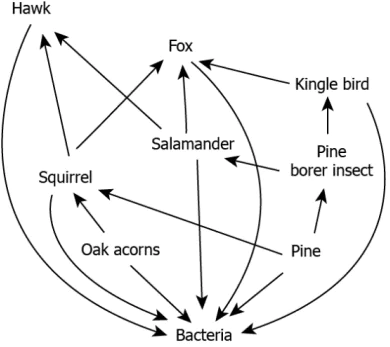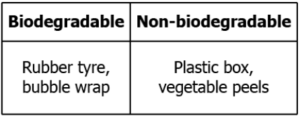Hint: Classify biotic and abiotic components and their interaction with each other, in order to describe an ecosystem.
Question.1. The table lists some components of an ecosystem.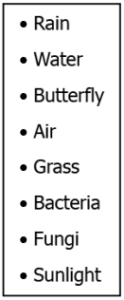
(a) 


Question.2. Which statement shows interaction of an abiotic component with a biotic component in an ecosystem?
(a) A grasshopper feeding on a leaf.
(b) Rainwater running down into the lake.
(c) An earthworm making a burrow in the soil.
(d) A mouse fighting with another mouse for food.
Ans.1. (c) 
Hint: Tabulate the organisms feeding on one another (producers, consumers, decomposers) and energy transfer between them, in order to form a food chain or a food web.
Question.3. The table shows some organisms including plants, animals and how they get energy.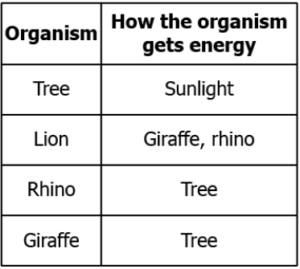
(a) 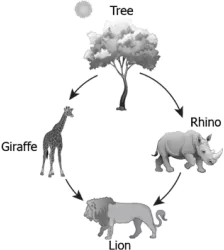
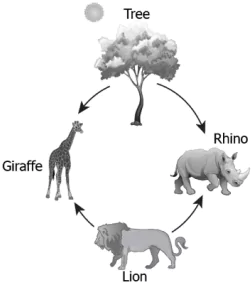
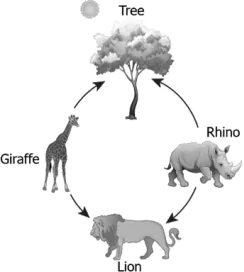
Question.4. The image shows a food web.
(a) Fox feeds on hawk obtain energy.
(b) Hawk feeds on oak acorn to obtain energy.
(c) Squirrel feeds on pine borer to obtain energy.
(d) Salamander feeds on pine borer to obtain energy.
Ans.3. (a) 
Hint: Describe the formation & properties of ozone, in order to identify ways to protect it from depletion.
Question.5. The manufacturing of Chlorofluorocarbons free refrigerators is mandatory throughout the world. How this help prevent ozone depletion?
(a) This will help convert oxygen molecules into ozone.
(b) This will help convert the CFCs into ozone molecules.
(c) This will reduce the production of CFC from oxygen molecules.
(d) This will reduce the release of CFCs that reacts with ozone molecules
Question.6. Ozone forms by combination of free oxygen atoms and oxygen molecules. How do free oxygen atoms form at higher levels of atmosphere?
(a) by splitting of molecular oxygen into free oxygen atoms in the presence of low energy UV radiations
(b) by splitting of a molecular oxygen into free oxygen atoms in presence of high energy UV radiations
(c) by the combination of two molecular oxygen in the presence of high energy UV radiations
(d) by the combination of two free oxygen atoms in the presence of lower energy UV radiations
Ans.5. (d) This will reduce the release of CFCs that reacts with ozone molecules
Ans.6. (b) by splitting of a molecular oxygen into free oxygen atoms in presence of high energy UV radiations
Hint: Classify different waste products as biodegradable or non-biodegradable, in order to assess their effect on environment.
Question.7. The table lists some waste products.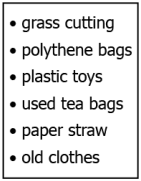
(a) plant waste, used tea bags
(b) polyethene bags, plastic toys
(c) used tea bags, paper straw
(d) old clothes, broken footwear
Question.8. The table shows some waste materials that changed and remain unchanged when buried in the soil. 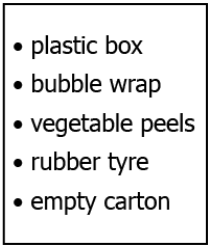
(a) 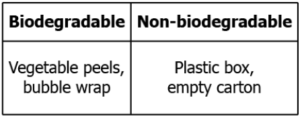
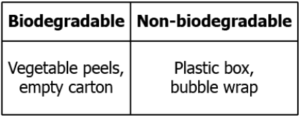
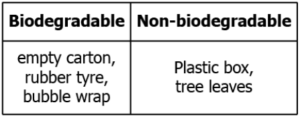
Ans.7. (b) polyethene bags, plastic toys
Ans.8. (b)



